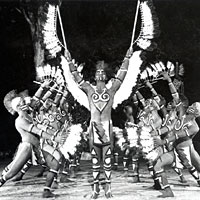 |

切羅基人(Cherokee)的鷹舞,
北卡羅來納州,1968年

|
 |
|
 |
穿越這些丘陵
地方性遺產
最好的戲劇題材常來自於真實生活。每年夏天,北卡羅來納的切羅基人(Cherokee)會演出一部名為「穿越這些丘陵」 (Unto
These Hills) 的戲。它述說著切羅基印地安人的歷史,包括離開位於喬治亞州的家鄉並出發前往俄克拉荷馬州的旅途過程。這段旅程被稱為「淚水小徑」(Trail
of Tears),您知道它為什麼被稱做淚水小徑嗎?
切羅基印地安人原本住在美國的東南部。但到了1700年代晚期,白人殖民開始掠奪他們的土地。1838年及1839年時,美軍甚至逼迫15,000名切羅基人離開他們位於喬治亞州的家鄉,遷移至東北方的俄克拉荷馬州。在這段長達116天的旅程中,約有4,000名切羅基人死於飢餓、寒冷的天氣、疾病及精疲力竭,所以這段旅程又名「淚水小徑」。然而,並不是所有的切羅基人都離開喬治亞州,有幾百人設法脫逃至山上,而現在他們的後代就住在北卡羅來納州。
時至今日, 穿越這些丘陵戲中的部分演員,就是這些切羅基印地安人的子孫。
這張照片中的演員正在表演切羅基印地安人的鷹舞(Eagle
Dance),它原本是勝利慶典上的舞蹈`。因為老鷹擁有強大的力量,所以切羅基印地安人相當尊敬老鷹。
Often the best material for drama comes from real life. Each summer, a play called Unto These Hills is performed in Cherokee, North Carolina. It tells the history of the Cherokee Indians, including the journey they took from their homes in Georgia to Oklahoma. This journey is called the "Trail of Tears." Do you know why?
The Cherokee Indians lived in the southeastern United States. By the late 1700s, white settlers began taking their land. In 1838 and 1839, U.S. troops forced 15,000 Cherokees to march from their homes in Georgia to northeastern Oklahoma. About 4,000 Cherokees died from starvation, cold weather, illness, and exhaustion from the long 116-day journey. That march is known as the "Trail of Tears." Not all Cherokees left Georgia, however. A few hundred managed to escape to the mountains, and their descendants now live in North Carolina.
Today, some of those Cherokee Indian descendants take part in the play, Unto These Hills.
In this photograph, players are performing the Cherokee Eagle Dance, which was originally a victory celebration. The Cherokees respect and honor the eagle because of its strength.

1/1 頁

關於地方性遺產

|





